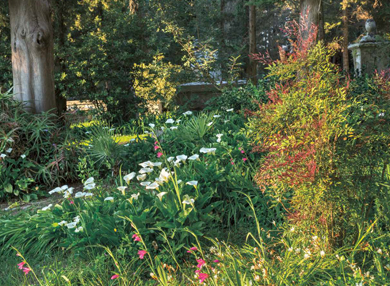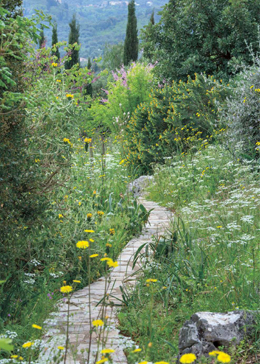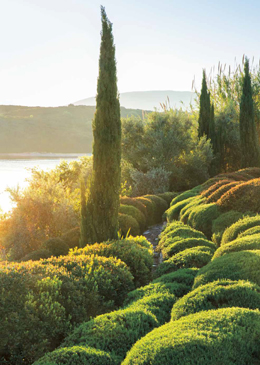Rachel Weaving
Impress 2018

I have seen Gardens of Corfu described as a coffee table book – it is certainly not! Whilst the definition implies lots of photographs – there are, and they are superb, what else would one expect from Marianne Majerus? It also infers they are not for ‘proper’ reading and this book most definitely is. Rachel Weaving, in her beautiful and succinct writing, has included detail of Corfu’s fascinating and complex history and its influence on the stunning gardens she has chosen, with detailed descriptions of the planting, including the Latin names, which for those of us who are gardeners, is important. As Mary Keen says at the end of her preface to the book: ‘lovers of Corfu and gardens will find plenty of magic in the pages that follow’ and she knows Corfu well as she has been involved with Lord Rothschild’s estate there for many years.
I should perhaps declare an interest at this point. 40 years ago, I and my ex-husband bought a tiny house up a goat track in an olive grove (still with no vehicular access, not even a quad bike!) on the island of Paxos, an hour’s ferry journey south of Corfu. When we bought the house our only water supply was that which fell on the roof during the winter. It was stored in a sterna (cistern) under the terrace and pumped up to a tank as required. Now we also have desalinated mains water. Anything heavy and bulky needed for the house or garden required a donkey. When I asked a Greek friend to write down for me the word for a spade he said “Liz, you won’t need that you will need this’” and gave me a pickaxe! How true! The house now belongs to my step-daughter but I can go whenever I like – usually in late September when there is less to do in my Aveyron garden and when the wild cyclamen cover the floor of the olive groves. Magic indeed.
Corfu is a very green island and has been called The Garden Isle. It was thought to be Homer’s model for the island of the Phaeacians. The winter rainfall is 44% higher than that of London’s annual rainfall and over half of the landscape is olive and cypress trees. It is this heavy rainfall that creates the spectacular spring flowering described in the book. Edward Lear wrote of ‘gardens dark with orange and lemon groves, their fruit sparkling golden and yellow against the purple sea and amethyst hills’.
The content of the book is clearly laid out. It starts with a brief history of the island, and moves on to soil, water, the weather which governs the island’s landscape and the types of gardening possible. The overwhelming message, throughout the book, is that it is a landscape that one works with. It is also clear that its history has dictated in part the style of some of the historical gardens – the Venetian ironwork, the olive trees themselves – which led to olive oil production and in turn its storage in the huge terracotta pots still in existence, albeit often damaged, (ours were stolen!).
Following on from an outline of Corfiot style, Rachel Weaving continues with a description of the Heritage Gardens. These are historically fascinating, particularly when one considers the age of the non-native trees which resulted from the links to world trade routes. For example, the eucalyptus arrived and was valued because it is thirsty and drained the marshy ground that hosted the malarial mosquitoes.
The author describes seven Historical Gardens in detail. The photos are beautiful – huge ancient palms and oaks and wonderful old houses, many built in the fifteenth and sixteenth centuries and painted in the distinctive Corfiot/Venetian red. The British Cemetery is, for me, the best kept secret, I knew nothing about it. The earliest grave dates back to 1817 and in spring, 30 varieties of orchid (of the 50 on the island) can be found there.


| San Stefano, built by a Venetian family in the 1780s | The British Cemetery |
The book continues with the green spaces of Corfu town and the many village gardens with their tiny potagers, their brugmansias and many flowering plants in oil tins and pots.
Contemporary Gardens, the largest section of the book, follows. Sixteen are described in detail, accompanied by stunning photographs. Most of the gardens have been designed by professional garden designers and include both restoration and new-build, some clearly intended for commercial use. They were, I am sure, expensive creations and where appropriate the names of both the designers and the gardeners who maintain them are given, which is a nice touch, sadly the latter are too often ignored.
I read all this with some envy – my Paxos gardening technique is to go to the only (new) garden centre on the island at the beginning of my stay. In the old days it was a question of getting a taxi from Corfu airport, stopping at a tiny nursery nearby and carrying everything onto the ferry. Now I buy what plants I want, plant them with my pickaxe, water in well all week and then, as I leave, close the gate whilst praying for rain with my fingers crossed. Amazingly it seems to work! But I can only plant in the early autumn, not in the spring, as the latter requires regular watering throughout the summer.
Several of the houses and gardens have had significant engineering to integrate them into the beautiful landscape, particularly on the rocky coastal areas, letting the latter determine the layout. The thoughtful planting has often been done in two ways, by ‘taming’ the existing trees and shrubs with strategic pruning, or by new planting to complement the former. Nicole de Vésian has reached Corfu! Heidi Gildemeister and Olivier Filippi have both been influential in the planting philosophy of these gardens as almost all plants have to survive with little or no summer watering other than when first planted. The planting in all the gardens is beautiful and well-established. In general, it becomes freer in style as one moves away from the houses to the extremities of the land, with lovely walks meandering among olive trees and more natural plantings. In the descriptive text I would have liked even more concerning the water situation. Grey water is mentioned only once, when it should be really easy to organise its collection in a new building. Are sternas still being built to store rainwater for use in the summer? It is all very well for people to say that their water comes from their own wells but with so many swimming pools being built, requiring huge amounts of water, Rachel Wearing says that the natural water levels of the aquifers are diminishing for the local, less-wealthy, population and this is encouraging sea water to infiltrate, making the water useless for drinking and irrigation. As climates change, water is going to be a major issue.


| Kassiopa Estate. Native trees enhanced with Teucrium fruticans | Cavo Alkyóni. Clipped shrubs follow the contours of the hillside. |
Contemporary Gardens are followed by Wild Gardens. This section goes into more detail than previously about the Corfu landscape and explains why so many of the contemporary gardens are influenced by the wild landscape. It describes the wild flowers which appear throughout the year, particularly orchids, accompanied by detailed photographs. Also included is a piece on Useful Plants, divided into wild greens, known in Greece as hórta, and which any of us who live in rural France are familiar with, and lastly, plants for flavours and cures.
The index is excellent. Split into two parts, plants are listed by their common names followed with their Latin name and then a general index.
If I have any concerns about the book it is about its design. Firstly, I think it is too big – for me anyway. It is almost 36cm tall. Difficult to balance on a lap. The last gardening books I have read have been around 30cm – Arne Maynard and Jinny Blom, for example, are much easier though even heavier in one case. I am really only comfortable reading The Gardens of Corfu at a table (and not a coffee table!). And it doesn’t have a book mark, which for such an informative and expensive book (£50) it should. It does have one very good feature though, the dust cover has a folded top and bottom which means it is much less likely to catch and tear.
Don’t whatever you do allow this to stop you from buying it! The book is a treat from beginning to end and if you look on the book’s website there are details of garden events on the island.
Review by Liz Godfrey – Mediterranean Gardening France
